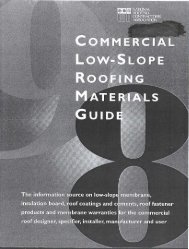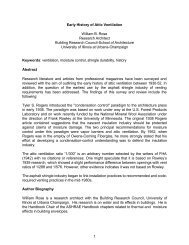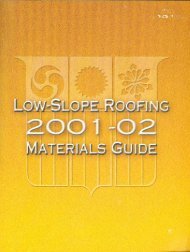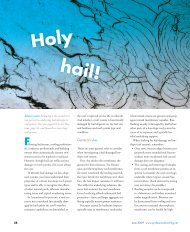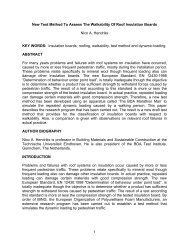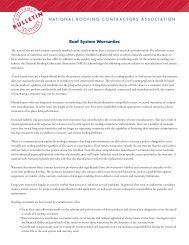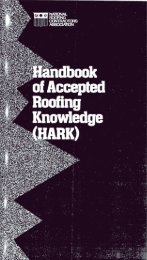26 January 2010 www.professionalroofing.net
26 January 2010 www.professionalroofing.net
26 January 2010 www.professionalroofing.net
Create successful ePaper yourself
Turn your PDF publications into a flip-book with our unique Google optimized e-Paper software.
Without air retarderAir intrusion = 27 L/m 2 = 100%Sheet width = 3 feetWith air retarderAir intrusion = 54 L/m 2 = 200%Sheet width = 6 feetAir intrusion = 88 L/m 2 = 330%Air intrusion = 13 L/m 2Minimum of 50%reduction in air intrusionSheet width = 10 feetFigure 3: Air intrusion volume of the tested mechanically attached roof assembliesto improved wind-uplift performance,questions arise whether it is necessarythat an air retarder be completely airimpermeableto achieve the required winduplift-resistancerating. It should be understoodthat some quantity of air intrusionmay negatively affect roof system performancein terms of wind uplift, condensationand energy.Good design practice tells us to preventthe movement of moisture-laden air intoroof assemblies, which can be achieved byinstalling a continuous air retarder at thedeck level. However, complete airtightnesscan lead to trapped vapor between twoimpermeable air retarders, which begs thequestion: What is the maximum allowableamount of air intrusion that can be toleratedin a mechanically attached roof systembefore moisture entry and the attendingrisk of condensation will adversely affectits performance?To answer this question, a research projectis in progress in collaboration withNRCA; the Canadian Roofing Contractors’Association; Carlisle SynTec Canada, Oakville,Ontario; Dow Roofing Systems, Holyoke,Mass.; Firestone Building Products Co.,Mississauga, Ontario; and Sika Sarnafil, abusiness unit of Sika Canada, Mississauga.The study aims to establish air intrusionlimits in mechanically attached roof systemsfor building code recommendations.Next stepsThrough a new ASTM International testprotocol, research at NRC has definedthe volume of air intrusion occurring inmechanically attached roof systems. Dataindicate that systems with larger sheet widthshave higher volumes of air intrusion comparedwith systems with narrower sheetwidths, and the presence of air retarderscould reduce a minimum of 50 percent ofair intrusion into the systems. To determi<strong>net</strong>he limits of air intrusion for buildingcode recommendations and quantifyair intrusion’s effect on condensation controland energy performance, further researchis being conducted by roofingorganizations.Bas Baskaran, Ph.D., P. Eng., is a group leaderand Suda Molleti, Ph.D., is a research officerfor the roofing subprogram at the NationalResearch Council of Canada’s Institute forResearch in Construction.32 <strong>January</strong> <strong>2010</strong> <strong>www</strong>.<strong>professionalroofing</strong>.<strong>net</strong>


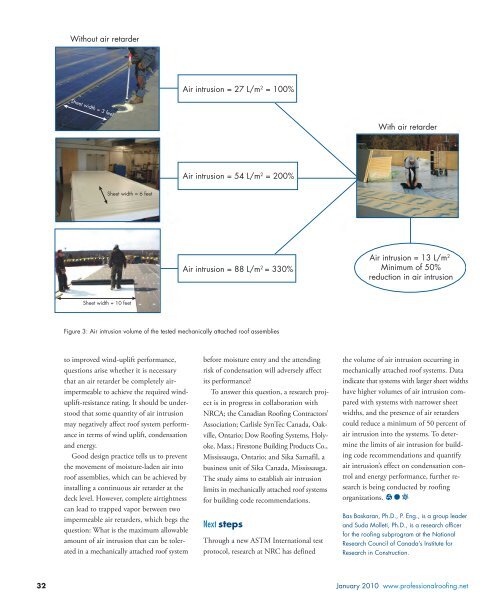

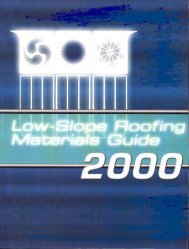

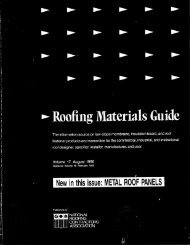
![Wm] - National Roofing Contractors Association](https://img.yumpu.com/36696816/1/190x245/wm-national-roofing-contractors-association.jpg?quality=85)

